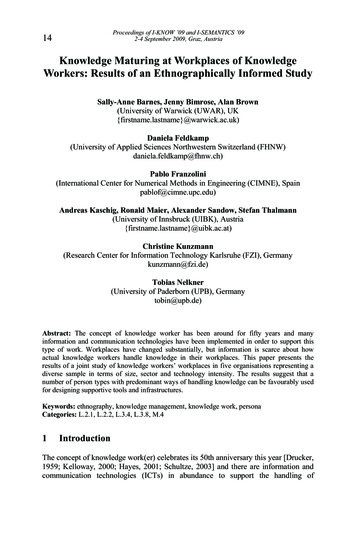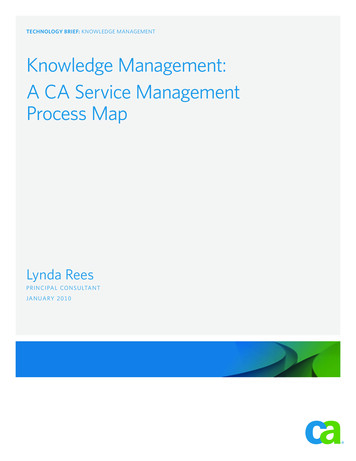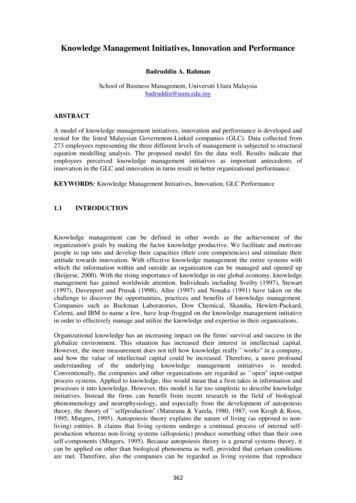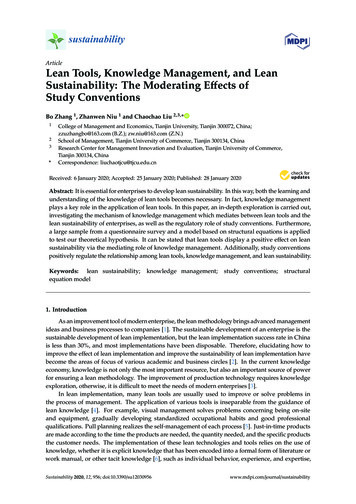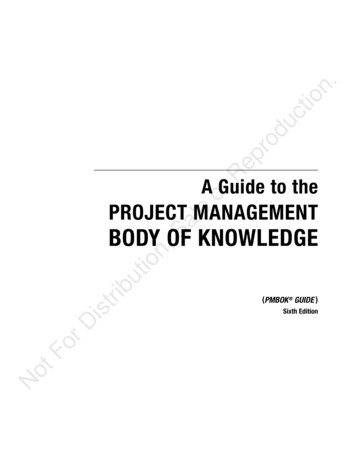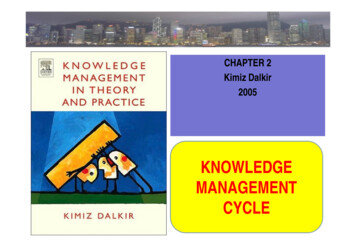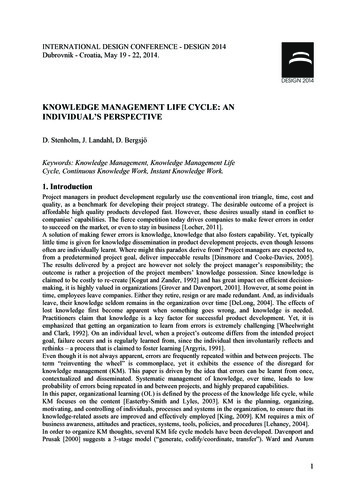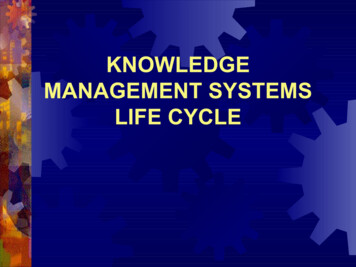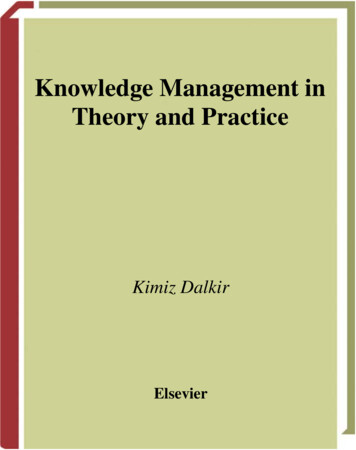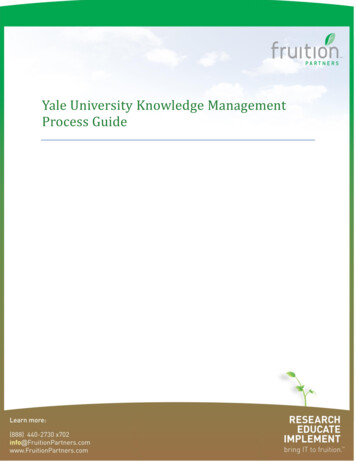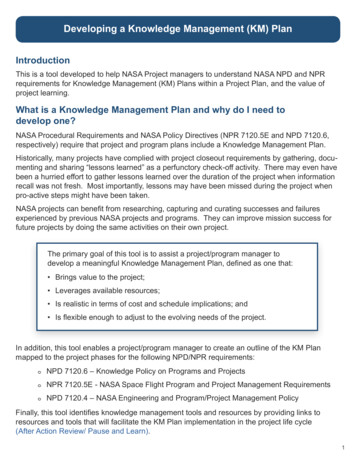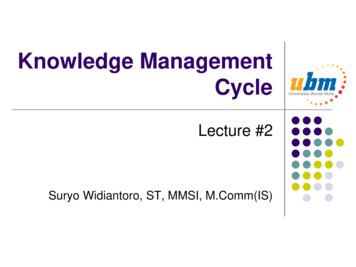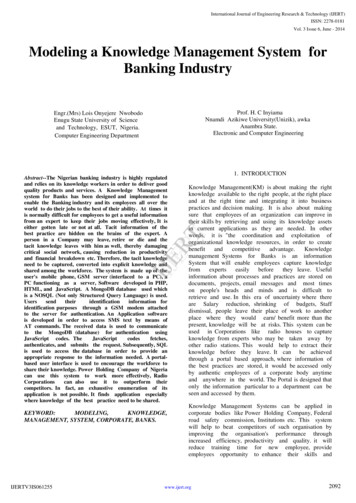
Transcription
International Journal of Engineering Research & Technology (IJERT)ISSN: 2278-0181Vol. 3 Issue 6, June - 2014Modeling a Knowledge Management System forBanking IndustryProf. H. C InyiamaNnamdi Azikiwe University(Unizik), awkaAnambra State.Electronic and Computer EngineeringEngr.(Mrs) Lois Onyejere NwobodoEnugu State University of Scienceand Technology, ESUT, Nigeria.Computer Engineering Department1. INTRODUCTIONKnowledge Management(KM) is about making the rightknowledge available to the right people, at the right placeand at the right time and integrating it into businesspractices and decision making. It is also about makingsure that employees of an organization can improve intheir skills by retrieving and using its knowledge assetsin current applications as they are needed. In otherwords, it is "the coordination and exploitation oforganizational knowledge resources, in order to gement Systems for Banks is an informationSystem that will enable employees capture knowledgefromexpertseasilybeforethey leave. Usefulinformation about processes and practices are stored ondocuments, projects, email messages and most timeson people's heads and minds and is difficult toretrieve and use. In this era of uncertainty where thereare Salary reduction, shrinking of budgets, Staffdismissal, people leave their place of work to anotherplace where they would earn/ benefit more than thepresent, knowledge will be at risks. This system can beused in Corporations like radio houses to captureknowledge from experts who may be taken away byother radio stations. This would help to extract theirknowledge before they leave. It can be achievedthrough a portal based approach, where information ofthe best practices are stored, it would be accessed onlyby authentic employees of a corporate body anytimeand anywhere in the world. The Portal is designed thatonly the information particular to a department can beseen and accessed by them.IJERTAbstract--The Nigerian banking industry is highly regulatedand relies on its knowledge workers in order to deliver goodquality products and services. A Knowledge Managementsystem for Banks has been designed and implemented toenable the Banking industry and its employees all over theworld to do their jobs to the best of their ability. At times itis normally difficult for employees to get a useful informationfrom an expert to keep their jobs moving effectively, It iseither gotten late or not at all. Tacit information of thebest practice are hidden on the brains of the expert. Aperson in a Company may leave, retire or die and thetacit knowledge leaves with him as well, thereby damagingcritical social network, causing reduction in productivityand financial breakdown etc. Therefore, the tacit knowledgeneed to be captured, converted into explicit knowledge andshared among the workforce. The system is made up of theuser's mobile phone, GSM server (interfaced to a PC), aPC functioning as a server, Software developed in PHP,HTML, and JavaScript. A MongoDB database used whichis a NOSQL (Not only Structured Query Language) is used.Userssendtheiridentificationinformation foridentification purposes through a GSM modem attachedto the server for authentication. An Application softwareis developed in order to access SMS text by means ofAT commands. The received data is used to communicateto the MongoDB (database) for authentication usingJavaScript codes. TheJavaScriptcodesfetches,authenticates, and submits the request. Subsequently, SQLis used to access the database in order to provide anappropriate response to the information needed. A portalbased user interface is used to encourage the workforce toshare their knowledge. Power Holding Company of Nigeriacan use this system to work more effectively, RadioCorporationscan also use it to outperform theircompetitors. In fact, an exhaustive enumeration of itsapplication is not possible. It finds application especiallywhere knowledge of the best practice need to be shared.KEYWORD:MODELING,KNOWLEDGE,MANAGEMENT, SYSTEM, CORPORATE, BANKS.IJERTV3IS061255Knowledge Management Systems can be applied incorporate bodies like Power Holding Company, Federalroad safety commission, Institutions etc. This systemwill help to beat competitors of such organisation byimproving the organisation's performance throughincreased efficiency, productivity and quality. it willreduce training time for new employee, provideemployees opportunity to enhance their skills andwww.ijert.org2092
International Journal of Engineering Research & Technology (IJERT)ISSN: 2278-0181Vol. 3 Issue 6, June - 2014 experience by sharing other peoples knowledge andlearning from experts.1.1 Problem Statement Banking is a risky business that has effect on the economyof a nation. This financial service industry is challengedon many fronts, all of them to some degree intertwined, The system should be able to upload andretrieve information, authenticate login, exerciseinformation search, forum discussion, chat andEmail.The system could be able to send back theinformation to the user.The system can be customized to meet thedemand of any envisaged user.2.0 Knowledge Management In The Bankand critical to restoring the health and sustainable growthof the industry.One of the problems the banking sector has worldwide isinefficiency in customers services. A customer stays ina long queue while waiting for services. A customer maythus miss most important appointments, and this couldlead to loss of customers. At times banks server/ systemwill be down for hours and days, thereby disorganizingboth the plans of the employee and the customers. Cashingcheques from other banks take especially if in differentstates with the drawee‟s bank. Banks machinery andequipments are abandoned by employee that has beenoffered a better pay elsewhere, thereby losing theknowledge of that completely if it was not codified.Without the proper management of information system,vital information are lost. Meanwhile being aware of therole information plays, banks are now making it a matterof precedence to capture, store and share knowledge inorder words manage knowledge. However, the lack ofprocess definition, classification, a comprehensiveknowledge management model, and suitable knowledgebased business model make the efforts futile in the lastdecade.IJERTNew employees undergo some training not less than6month (at times not in his state) before starting his newjob, the concept of coding and transmitting knowledge inorganizations is not new. Training and employeesdevelopment programs, organization policies, routines,procedures, reports, and manuals have served this functionfor years. At times information gotten may be inaccurate ifgotten at all. By capturing, codifying, and disseminatinginformation on know how, the bank is run by bestpractices.Over the years, banks have utilized their manual process,this has brought the presence of electronic systems that hasenabled them to handle large volumes of data and tomanage their banking processes and at the same timecaused them problems and setback. If an information isneeded, one has to go through the pool of information inorder to bring a perfect solution. When there are loads ofinformation it could result in less reactive responses anddecline of capacity. With huge amount of curs.Consequently, efficient and effectiverecovery ofknowledgeis increasingly becoming an importantresearch issue in recent times.1.2 Aims and ObjectivesApplication of knowledge management will make bankshave the advantage to outperform their competitors. Apartfrom large volumes of information, the use of informationtechnology (IT) in managing knowledge has givenknowledge management a new dimension. With theappropriate strategies, IT could help to carry out andmaximize the benefits ofmanagement initiatives,including knowledge management.At the end of this paper, the system should be able toachieve the following:2.1 Concept of knowledge, knowledge management,knowledge management systemRetaining knowledge of the best practice is difficultsince it is an order of the day to dismiss any employeewho have worked for years but could not meet their target,when such an employee leaves, his knowledge assets leaveswith him. Develop a data capture interface for each unitin a bank organisation that will match the waythey prefer to present the information theyhave to share and to store the informationgotten in a repository.Use a portal based approach for offeringinformation to each unit so that onlyinformation concerned about that unit will begotten by them when accessing sharable data.Develop a systematic plan of action fortracking and remuneratingpeoplewhowillingly share their knowledge.IJERTV3IS061255Knowledge: It includes familiarity, awareness andunderstanding gained through experience or study, ences, and making connections. It could also meanexpertise, and skills acquired by a person throughexperience or education; the theoretical or practicalunderstanding of a subject.www.ijert.org2093
International Journal of Engineering Research & Technology (IJERT)ISSN: 2278-0181Vol. 3 Issue 6, June - 2014Knowledge Management: This is when an enterpriseconsciously and comprehensively gathers, organizes,shares, and analysesits information with which theywork, such information can be possessed by few membersof that corporation. By sharing such knowledge, thecompany is run by best practices.Categories of knowledgeTable 1: Types of KnowledgeExplicitImplicitDescriptionIt is knowledge stored in the headsof people which cannot be used byothers. It islearningbyobservation, interview etc. It canonly be transmitted throughtraining, socializing or gainedthrough personal experience. Itincludes people‟s beliefs, values,intuition and expectations. It isdifficult to communicate and share.ExamplesIn throwing a ball.It is knowledge that can bearticulated, codified, and stored. Itcan be transmitted to others easily.Implicit knowledge is acquiredrelativelydirectly from the environment andrequires substantially less mentaleffort during the learning process.Despite its relatively effortlessmanner,onecommonmisconception aboutimplicitlearning is that it does not requireattention to the subject matter.Book knowledge, images, manual,booklet, documents, numbers andformulas1. learning geographic informationabout an area simply by driving toa different city even without havingan intention to learn.2. Attending to a task; they are justnot deliberately trying to acquirecertain aspects of the task stimuli.IJERTTypes of knowledgeTacitDriving a nail.Learning through observation,practice and trainings e. g learningfrom a masterKNOWLEDGE MANAGEMENT PROCESSESKnowledge management processes and it‟s barriers.1. Knowledge Identification: A knowledgeidentification culture in an organisation thatis badly role-modelled by those highest in theorganisation‟s hierarchy and knowledgehoardingcanhinderknowledgeidentification. High ranking staff mayconsider themselves to be more importantthan others and refuse to share(ie hoard)their knowledge. Also lack of expertise in theorganization is a barrier.2.IJERTV3IS061255KnowledgeAcquisition: Internet isconsidered one of the main tools forcapturing knowledge and informationhowever people particularly in ruralcommunities may not have access to it, notKnowledge management techniquesConsulting a content expert who has long timeexperience in the field of interest. - Sub regionalWorkshops: create opportunities for face- to-facemeetings and learn from one another. - Informationcoordinators: can point the key documents, Websites,databases and experts. Appropriate ICT solutionscould support this process.These can be extracted mainly from the humanexpert, by the following means:www.ijert.orgi.ii.By task analysisDocumentation2094
International Journal of Engineering Research & Technology (IJERT)ISSN: 2278-0181Vol. 3 Issue 6, June - 2014iii.iv.v.vi.vii.viii.ix.know how to (better) use it. In any case, timemay be wasted while searching for usefulinformation. Information may be on people‟shead that they may be reluctant to share it.Story tellingInterviewing ExpertsLearning by being toldQuestionnaireLearning from othersBrain storming or Ad-hoc sessionInterviewsKnowledge Sharing. It shifts the KM teaminto „solutions mode‟. Knowledge sharinginitiatives may focus on implementing a newexpertise directory, or on improvingcollaboration tools. While these solutionsmay be potentially useful, if they don‟t meetspecific business needs they won‟t be widelyused (if at all). Most organisations are nowlittered with unused systems as the result ofthis emphasis on delivering knowledgemanagement solutions.These could be achieved through the use of internet,intranet, GSM, Portal, Emails, video conferencing,search engine, instant messaging.4.Knowledge Storage. Because of the largevolume of knowledge in the bank, an SQLdatabase will not suffice. Bank Knowledge isbetter stored in a No SQL database.By the use of a repository, knowledge warehouse,database etc.5.Knowledge Use: Lack of expectancy due tothe perception that implementation will notlead to improved outcomes for either theemployee or the organization, inadequatemotivation due to the threat to professionalautonomy that jeopardise people‟s jobsecurity, lack of awareness, familiarity andForgetfulness.With a knowledge directory, one can easily findpeople who have specific knowledge.6.Knowledge Management Measurement: Lackof proper appraisal from the currentknowledge in the organisation.Notify who accesses andwho contributesinformation. Develop a way to remunerate those whouse best practices.IJERT3. Knowledge Management System: This could be said tobe any information system that will be able to capture,store, retrieve, improve collaboration and innovation, useknowledge. It could be said to be a system that managesknowledge.
Modeling a Knowledge Management System for Banking Industry . Prof. H. C Inyiama Nnamdi Azikiwe University(Unizik), awka . Anambra State. Electronic and Computer Engineering . Abstract--The Nigerian banking industry is highly regulated and relies on its knowledge workers in order to deliver good quality products and services. A Knowledge ManagementAuthor: Engr. Lois Onyejere Nwobodo, H. C. InyiamaPublish Year: 2014
